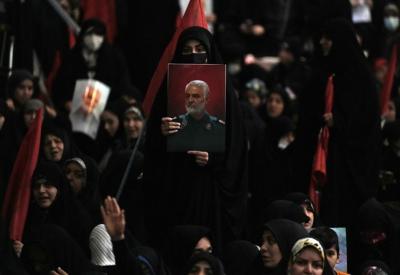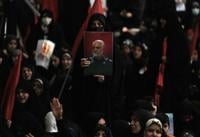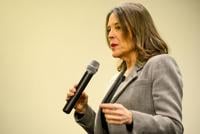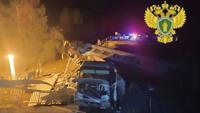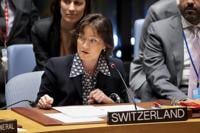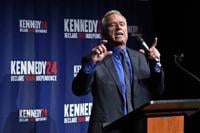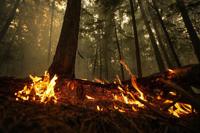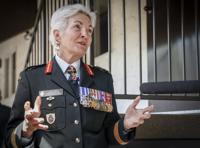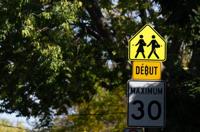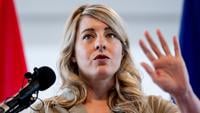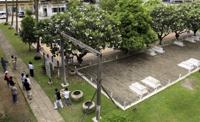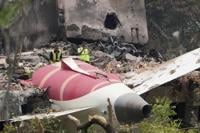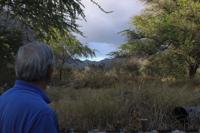TEHRAN, Iran (AP) — For Iranians backing the country's theocracy, whose icons since the Islamic Revolution have been stern-faced clergymen, Gen. Qassem Soleimani represented a popular figure of national resilience in the face of four decades of U.S. pressure.
For the U.S. and Israel, he was a shadowy figure in command of Iran's proxy forces, responsible for fighters in Syria backing President Bashar Assad and for the deaths of American troops in Iraq.
Solemani survived the horror of Iran’s long war in the 1980s with Iraq to take control of the Revolutionary Guard’s elite Quds Force, responsible for the Islamic Republic’s campaigns abroad.
Relatively unknown in Iran until the 2003 U.S. invasion of Iraq, Soleimani's popularity and mystique grew after American officials called for his killing. A decade and a half later, Soleimani had become Iran's most recognizable battlefield commander, ignoring calls to enter politics but growing as powerful, if not more, than its civilian leadership.
“The warfront is mankind’s lost paradise,” Soleimani said in a 2009 interview. “One type of paradise that is portrayed for mankind is streams, beautiful nymphs and greeneries. But there is another kind of paradise. ... The warfront was the lost paradise of the human beings, indeed.”
The Pentagon said then-President Donald Trump ordered the U.S. military to take “decisive defensive action to protect U.S. personnel abroad by killing” a man once referred to by Iran's Supreme Leader Ayatollah Ali Khamenei as a “living martyr of the revolution.”
His name again drew international attention on Wednesday, as killed at least 84 people and wounded 284 others. The extremist Islamic State group, a battlefield foe of Soleimani, .
“These hard-hearted criminals could not tolerate the love and enthusiasm the people had to visit the shrine of their great commander, Qassem Soleimani,” Khamenei said in a statement after the attack. “Let them know that the soldiers of ... Soleimani will not tolerate their vileness and crimes.”
Soleimani's luck finally ran out in 2020 after he was rumored dead several times over the years. There was a 2006 airplane crash that killed other military officials in northwestern Iran and a 2012 bombing in Damascus that killed top aides of Assad. Rumors again circulated in November 2015 that Soleimani had been killed or seriously wounded leading forces loyal to Assad as they fought around Syria’s Aleppo.
As tensions between the U.S. and Iran increased after Trump pulled out of Tehran's nuclear deal with world powers, Iranian officials quickly vowed to retaliate. While Soleimani was the Guard's most prominent general, many others in its ranks have experience in waging the asymmetrical, proxy attacks for which Iran has become known.
“Trump through his gamble has dragged the U.S. into the most dangerous situation in the region,” Hessameddin Ashena, an adviser to Iran’s former President Hassan Rouhani, once wrote. “Whoever put his foot beyond the red line should be ready to face its consequences.”
Details of Soleimani's early years remain few. Born March 11, 1957, Soleimani grew up, Iranians say, near the mountainous and historic Iranian town of Rabor, famous for its forests, its apricot, walnut and peach harvests and its brave soldiers. The U.S. State Department has said he was born in the Iranian religious capital of Qom.
Little is known about his childhood, though Iranian accounts suggest Soleimani’s father was a peasant who received some land under the Shah Mohammad Reza Pahlavi, the monarch who was toppled in the 1979 Islamic Revolution.
By the time he was 13, Soleimani was working construction, later as an employee of the Kerman Water Organization. After Iran’s Islamic Revolution swept the shah from power, Soleimani joined the Revolutionary Guard. He deployed to Iran’s northwest with forces that put down Kurdish unrest.
Soon after, Iraq invaded Iran and began the two countries' long, bloody eight-year war. The fighting saw Iran send waves of lightly armed troops into minefields and the fire of Iraqi forces, including teenage soldiers. Solemani’s unit and others also were attacked by Iraqi chemical weapons.
Amid the carnage, Soleimani became known for his opposition to “meaningless deaths” on the battlefield. He wept with fervor when exhorting his men into combat, embracing each individually.
For several years after the Iraq-Iran war, Soleimani largely disappeared from public view, something analysts attribute to his wartime disagreements with Hashemi Rafsanjani, who served as Iran’s president from 1989 to 1997. But after Rafsanjani, Soleimani became head of the Quds Force. He also grew so close to Khamenei that the Supreme Leader officiated the wedding of the general’s daughter.
As chief of the Quds Foce — or Jerusalem Force — Soleimani oversaw the Guard’s foreign operations and soon would come to the attention of Americans following the 2003 invasion of Iraq and the overthrow of Saddam Hussein.
In secret U.S. diplomatic cables released by WikiLeaks, U.S. officials openly discussed Iraqi efforts to reach out to Soleimani to stop rocket attacks on the highly secured Green Zone in Baghdad in 2009. Another cable in 2007 outlines then-Iraqi President Jalal Talabani offering a U.S. official a message from Soleimani acknowledging having “hundreds” of agents in the country while pledging: “I swear on the grave of (the late Ayatollah Ruhollah) Khomeini I haven’t authorized a bullet against the U.S.”
U.S. officials at the time dismissed Soleimani’s claim as they saw Iran as both an arsonist and a fireman in Iraq, controlling some Shiite militias while simultaneously stirring dissent and launching attacks. U.S. forces blamed the Quds Force for an attack in Karbala that killed five American troops, as well as for training and supplying the bomb makers whose improvised bombs made IED — improvised explosive device — a dreaded acronym among soldiers.
In a 2010 speech, U.S. Gen. David Petraeus recounted a message from Soleimani he said explained the scope of Iranian’s powers.
“He said, ‘Gen. Petraeus, you should know that I, Qassem Soleimani, control the policy for Iran with respect to Iraq, Lebanon, Gaza and Afghanistan,’” Petraeus said.
The U.S. and the United Nations put Soleimani on sanctions lists in 2007, though he continued to travel. In 2011, U.S. officials named him as a defendant in an outlandish Quds Force plot to allegedly hire a purported Mexican drug cartel assassin to kill a Saudi diplomat.
The attention the West gave Soleimani only boosted his profile at home. He sat by Khamenei's side at key meetings. He famously met Syria's Assad together with the supreme leader — but without Iran's then-Foreign Minister Mohammad Javad Zarif, sparking a short-lived resignation by the top Iranian diplomat.
Polling data at the time routinely showed Soleimani rated more favorably than other public figures, according to the Center for International Studies at the University of Maryland. But Soleimani refused entreaties to enter politics, even as elections saw lackluster turnout and widespread protests against the country's theocracy began sweeping Iran and intensified in the years after his death.
Just before Wednesday's anniversary, Khamenei met with Soleimani's family — showing his continued prominence.
Soleimani's greatest notoriety arose from the Syrian civil war and the rapid expansion of the Islamic State group. Iran, a major backer of Assad, sent Soleimani into Syria several times to lead attacks against IS and others opposing Assad’s rule. While a U.S.-led coalition focused on airstrikes, several ground victories by Iraqi forces featured photographs of Soleimani leading them without a flak jacket.
"Soleimani has taught us that death is the beginning of life, not the end of life," one Iraqi militia commander said.
___
Gambrell reported from Dubai, United Arab Emirates.
___
EDITOR'S NOTE: This story, initially published Jan. 3, 2020, has been updated to incorporate details of Wednesday’s attack on a commemoration marking the fourth anniversary of Soleimani's killing.

